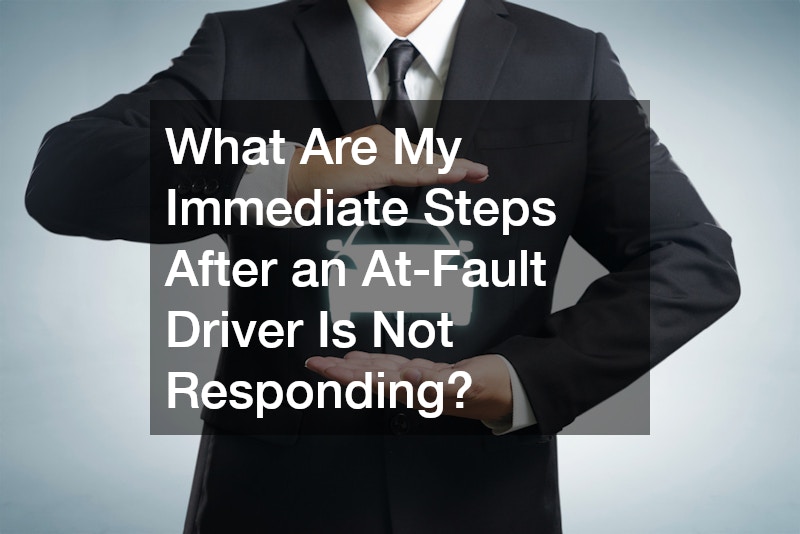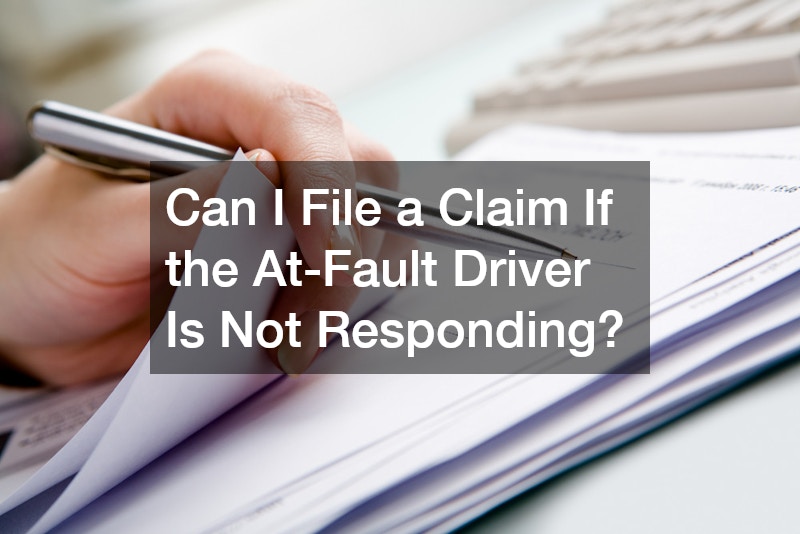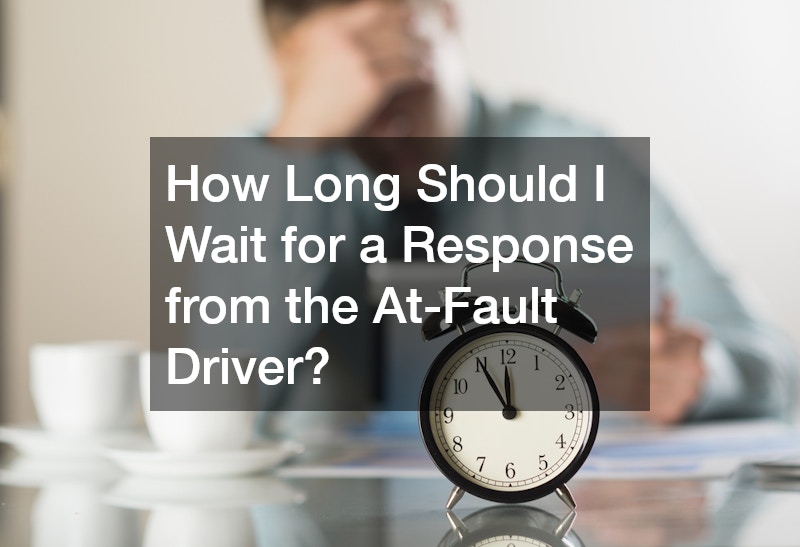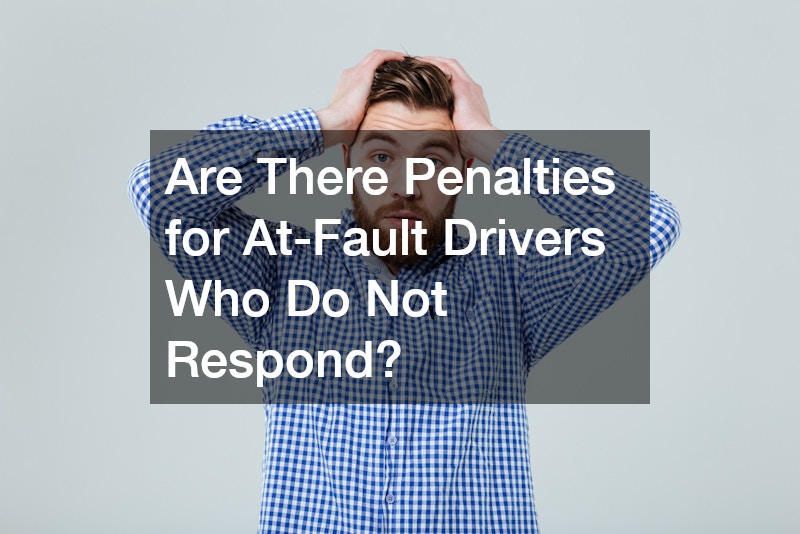Experiencing a car accident can be incredibly stressful, especially when the at-fault driver is not responding to attempts at resolution. Navigating this situation requires understanding the necessary steps and options available to you. This article delves into what you should do when an at-fault driver is unresponsive and explores various angles, from legal measures to insurance processes.
What Are My Immediate Steps After an At-Fault Driver Is Not Responding?

After ensuring everyone’s safety and calling emergency services, your priority should be gathering evidence immediately. Document the scene with photos, noting any damage and the position of vehicles, as this could be crucial for your insurance claim. Once immediate documentation is complete, consider how auto collision repair can help assess and record the physical damage to your vehicle.
Contacting your insurance company promptly after the accident is essential, even if the at-fault driver is not responding. Provide them with all pertinent details, including the other driver’s contact information and any evidence you’ve gathered. As you wait, consider consultations with auto mechanics to estimate repair costs, including potential windshield repairs.
Securing estimates for vehicle repairs is beneficial as it helps your understanding and the insurance claim process. Auto mechanics can provide detailed assessments and reports, which may be required if the case moves into legal arbitration. Additionally, getting early input on replacement windshields may save time if the repairs progress further.
How Does Insurance Handle a Non-Responsive At-Fault Driver?
When an at-fault driver is not responding, insurance companies initiate investigative procedures. The company will likely try contacting the at-fault driver directly, using any details from the accident report. Personal injury law often dictates that insurers have a duty to act in good faith and expedite claims whenever possible.
Insurance companies may sometimes advance funds for your repairs or medical expenses under your policy and then pursue the at-fault party on your behalf. This process can become complicated if the at-fault driver persists in their non-responsiveness. Insurance investigations explore alternative ways to establish liability and recuperate costs in such cases.
Understanding the terms of your insurance policy is crucial. Some policies include uninsured motorist coverage activated when the at-fault driver cannot be reached. Personal injury law provides frameworks that insurance companies use to handle these tricky situations.
Can I File a Claim If the At-Fault Driver Is Not Responding?

Filing a claim when the at-fault driver is not responding is possible. Begin by reporting the incident to your insurance provider with full details. Ensure all evidence is well-documented and readily available to support your claim.
In many cases, your insurance policy will have coverage plans, such as collision coverage or uninsured motorist protection, that can provide immediate financial assistance. Even if the at-fault party defaults by not cooperating, these policies can help expedite repairs and medical bills.
Your insurance company might also send in professional adjusters to independently assess the damage. These findings will help solidify your claim, ensuring that you receive appropriate compensation even without cooperation from the at-fault driver.
What Legal Actions Can Be Taken If the At-Fault Driver Doesn’t Respond?
Engaging an auto accident lawyer becomes imperative when an at-fault driver remains unresponsive. They can guide you through potential legal avenues to explore, including filing a lawsuit against the at-fault party. Using professional legal aid is often necessary to navigate the complexities of personal injury law.
Car accident lawyers specialize in these situations and can handle the burdensome aspects such as gathering evidence, managing communications, and strategizing legal actions. Their expertise ensures that your case progresses smoothly despite any non-cooperation from the other party. Having a legal advocate can greatly increase the chances of a favorable resolution.
A motorcycle accident lawyer specifically can also provide insights if your accident involved a motorcycle, as distinct legal and insurance considerations might apply. For workplace-related accidents with a similar unresponsive party, consulting a workers compensation lawyer is advisable.
If no resolution is found, an auto accident lawyer can help you file a formal lawsuit demanding damages from the at-fault party. Legal proceedings will compel the other party to respond or face further repercussions. The judge can enforce penalties, including fines and compensatory damages, to uphold your legal rights in court.
Pursuing legal action also involves gathering comprehensive documentation and presenting your case effectively. A strong legal team increases the likelihood of a judgment in your favor, ensuring you receive their due compensation. This step should be considered if other resolution means have been exhausted without success.
Filing a lawsuit can have broader implications, as it can influence future dealings with your insurance and potentially affect the at-fault driver’s insurance rates and legal standing. While this process can be lengthy, achieving justice and ensuring accountability often becomes necessary.
How Long Should I Wait for a Response from the At-Fault Driver?

The expected response time from an at-fault driver varies, but insurance companies typically advise waiting about two weeks. This period allows ample time for the other party to come forward and accept responsibility voluntarily. However, quicker resolution is always preferable, as delays could adversely impact your claims or legal strategy.
During this waiting period, you should regularly communicate with your insurance provider to stay updated on any contact attempts or developments. Keeping an eye on repair estimates is also crucial, as costs could escalate if immediate actions aren’t taken. Auto collision repair shops can sometimes offer guidance on expected repair timelines that complement claim processing periods.
If the at-fault driver persists in their silence beyond the initial waiting period, it’s advisable to consider alternative steps, such as engaging a lawyer or exploring mediation methods. Being proactive about your situation prevents inefficiencies and ensures quicker justice in your favor.
Setting definitive deadlines for responses is essential and must be communicated to all involved parties, including insurance companies and legal representatives. Deadlines provide structure and urgency, compelling the at-fault driver to act before facing legal proceedings or claim denials.
Deadlines can vary depending on your insurance provider, personal preference, and legal advice. Establishing formal deadlines may require legal communication, such as a demand letter or notice, which could prompt the at-fault driver to respond more effectively.
Consulting with a car accident lawyer can help set realistic and strategic deadlines tailored to your case. They can provide insights into standard time frames for response and guide you on how best to communicate these expectations appropriately.
What If the At-Fault Driver Is Ignoring Efforts to Contact Them?
If the at-fault driver is ignoring typical contact methods like phone calls and emails, it may be necessary to employ alternative communication strategies. Sending certified letters or using social media platforms may grab their attention and prompt a response. Every attempt at safe retrieval of communication evidence is recommended for potential legal deliberations.
Utilizing a lawyer to make contact can sometimes make the situation appear more serious to the at-fault party, prompting faster acknowledgment and responsibility. Legal presence can emphasize the importance of communication and increase the perceived risks of ignoring the situation.
A car accident lawyer can also explore utilizing process servers to establish in-person notices if traditional efforts fail. Employing more creative communication methods demonstrates diligence in seeking resolution and can positively influence how the case is handled legally or by insurance.
Another option when faced with a non-responsive at-fault driver is to involve third parties that can intervene on your behalf. Law enforcement agencies can play a pivotal role, especially if further investigation is needed. The police report can be essential when negotiating with insurance companies or legal representatives.
Your insurance provider can also act as a third party, leveraging their resources and legal teams to compel the negligent party to respond. They may have agreements with the other party’s insurer, easing contact and resolution through internal channels.
Seeking professional advice from a 24 hours bail services firm might indicate cases involving legal complications. Such resources can prove invaluable, especially if matters escalate into a legal framework requiring custody or immediate legal consultations and court dates.
Does Not Responding Affect the At-Fault Driver’s Liability?
Liability is typically determined based on the accident’s circumstances and evidence, irrespective of the at-fault driver’s responsiveness. However, non-response can reflect poorly during insurance investigations and court proceedings. In many jurisdictions, ignoring communications after an accident can exacerbate legal standing, implying negligence or avoidance.
Personal liability laws dictate that all drivers must respond in good faith to ensure proper resolution of any arising issues. Failing to engage can sometimes be admissible as evidence, indicating admission of guilt or deliberate evasion of responsibility.
the injured party must assert their rights explicitly, so non-responsiveness does not impact their entitlements. Documentation and evidence collection around these non-responses are vital when approaching insurers or courts, showcasing their unwillingness to cooperate.
Non-responsiveness from an at-fault driver can complicate the claims process, but it doesn’t automatically void the claim. Insurance companies are legally responsible for handling claims fairly, based on evidence and investigative outcomes. They may extend the claims process or take aggressive steps to receive a reconcilable outcome.
If the at-fault driver fails to respond, insurance companies may invoke other contractual elements, like uninsured motorist coverage, offering respite to the victim. Thus, while frustrating, dealing with an unresponsive driver doesn’t necessarily nullify your ability to receive due compensation for your damages.
A thorough understanding of liability laws and their impacts on insurance processes can better prepare the victim for such encounters. Utilizing car and auto accident lawyers to articulate claims accurately can provide advantages in dealing with unresponsive counterparts.
Are There Penalties for At-Fault Drivers Who Do Not Respond?

At-fault drivers who choose not to respond to accident claims can face several penalties, ranging from fines to legal damages awards. In some states, engaging in ADR (Alternative Dispute Resolution) is mandatory to settle disputes, and non-compliance could negatively influence judicial outcomes if brought to court.
Legally, ignoring the other party’s attempts at resolution can be construed as bad faith behavior, leading to harsher judgments or mandated compensation payments. Advisory from a car accident lawyer can help outline the potential legal ramifications and ensure you maintain leverage through such legal processes.
Insurance companies may blacklist serial non-responders, making it difficult for them to acquire insurance services in the future. Engaging services like 24-hour bail services come into play when additional legal conflicts emerge, highlighting the importance of avoiding unnecessary legal entanglements.
Non-response can influence an at-fault driver’s insurance costs and premium rates or even lead to policy cancellations. Insurers may take a dim view of drivers who ignore mandated communication, potentially affecting their ability to receive future coverage.
Insurance companies strive to maintain clean claim records and view non-contributing behaviors negatively, possibly applying further surcharges. Thus, an at-fault driver’s failure to reply harms their standing legally and may also carry unfavorable financial implications.
The impact on their driving record may also become more severe, making obtaining competitive insurance rates in the future a significant challenge. Advisement from professional auto accident lawyers can help ensure that non-responsive actions are noted and accounted for correctly during claims processing.
Can Mediation Help Resolve Issues with an At-Fault Driver Not Responding?
Mediation offers an alternative resolution avenue, encouraging both parties to find a mutual understanding through guided negotiation. The process involves a neutral third-party mediator facilitating communication, working towards resolving issues by promoting compromise.
Inviting an at-fault driver to mediation may prove appealing if extended court battles or protracted insurance claims are to be avoided. It provides both parties with a structured environment to articulate concerns and resolutions without the strain of legal formalities.
An experienced motorcycle or car accident lawyer can suggest certified mediators and offer guidance on constructively approaching such mediation. Their insights ensure that victim rights are represented and protected throughout the process.
Mediation processes typically initiate with an opening dialogue, where parties present their viewpoints and lay out expectations for resolution. The mediator aids by identifying common ground and fostering discussions that navigate the complexities of personal injury law and insurance claims.
The benefits of mediation include reduced costs, quicker resolutions, and a congenial atmosphere facilitating collective compromise. Mediation processes are less adversarial than court litigation, reducing stress for all involved and often leading to more satisfactory settlements.
Furthermore, mediation’s confidentiality barriers ensure that discussions remain privy to the parties involved, fostering openness in negotiation. The direction taken during mediation can further influence subsequent legal or insurance decisions, underscoring the merit of such integrations into resolute strategies.
What Should I Avoid Doing If the At-Fault Driver Is Unresponsive?
A critical mistake to avoid is not collecting sufficient evidence at the accident scene. Your case loses valuable leverage without proper documentation, whether dealing with the insurance company directly or through legal proceedings. Videos, photos, and witness statements are indispensable assets that should be secured immediately.
Additionally, avoid confronting or threatening the uninvolved driver. Such actions can be seen as harassment, complicating matters, or even putting you in an unintended legal hot spot. Maintaining composed communication channels through reliable means like insurance or legal representatives ensures professionalism and effectiveness.
Finally, avoid making presumptive conclusions about the non-responsiveness. There could be legitimate emergencies or reasons that delay their correspondence. Professional due diligence incorporated into all approaches sets a positive tone, increasing the chances of eventual resolution or acknowledgment.
Careful documentation of every interaction and communication attempt is vital, showcasing your diligence and consistency in seeking resolution. This includes keeping detailed records of call logs, emails, and any correspondences you send, even certified mail receipts, and documenting your proactive approach.
Efficiency in documentation provides solid footing should insurance claims become necessary or if legal pathways are pursued. Maintaining thorough records of all expenses incurred, such as auto collision repair, replacement windshields, and medical costs, ensures you have concrete proof of your claims.
Furthermore, thorough notes and organization validate your claims in front of adjusters or courts. This can depict transparency in managing the fallout effectively. A meticulous record-keeping system can be a deciding factor in the outcome of your case, empowering a fair resolution in light of non-response from the at-fault party.
Dealing with an at-fault driver not responding can be daunting, but informed steps and considerate actions can significantly enhance outcomes. You can optimize your chances of receiving fair compensation for your losses through proper documentation. You can explore insurance avenues and engage in legal counsel when necessary. Understanding and leveraging available resources such as mediation can also facilitate resolution, ensuring you find legal endpoints and personal peace from the incident.

